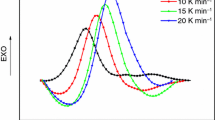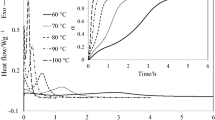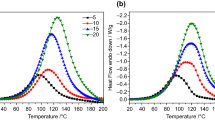Abstract
Different formulations, composed of the diglycidyl ether of bisphenol-A, diepoxidized cardanol as reactive diluent, an anhydride as curing agent, and a tertiary amine as curing catalyst, with/without the use of an epoxy fortifier, were analysed. The effect of the fortifier on the diluent was also observed. The overall kinetics of curing was observed to follow a simple Arrhenius-type temperaturedependence, with an activation energy in the range 54–120 kJ/mol, with first-order kinetics up to 85% conversion. An increase in activation energy was observed with an increase of diluent content. The curing reaction was found to follow a three-step mechanism, involving a nucleophilic bimolecular displacement reaction, for which an explanation was offered. Incorporation of the fortifier lowers the curing temperature, but does not alter the final degree of reaction.
Zusammenfassung
Es wurden verschiedene Ausgangsgemische, bestehend aus dem Diglyzidyläther von Bisphenol A, diepoxydiertem Kardanol als reaktives Streckmittel, einem Anhydrid als Vernetzungsmittel und einem tertiären Amin als Vernetzungskatalysator mit bzw. ohne Anwendung eines Fortifyers untersucht. Der Einfluss des Fortifyers auf das Streckmittel wurde ebenfalls untersucht. Die Bruttokinetik der Vernetzung zeigt eine Temperaturabhängigkeit einfachen Arrhenius-Types mit einer Aktivierungsenergie im Bereich von 54–120 kJ/mol sowie einen Reaktionstyp erster Ordnung mit einer Konversionsrate von 85%. Ein steigender Streckmittelgehalt bewirkt ein Anwachsen der Aktivierungsenergie. Der Vernetzungsreaktion liegt ein Dreistufenmechanismus zu Grunde, der unter anderem auch eine nukleofile bimolekulare Substitutionsreaktion beinhaltet. Der Einsatz eines Fortifyers senkt zwar die Vernetzungstemperatur, verändert aber nicht die Endkonversionsrate.
Резюме
Исследованы различн ые композиции, состоя щие из диглицидного эфир а бисфенолаА, диэпоксидированног о карданола, как разба вителя реакции, ангидрида, ка к вулканизирующего аг ента, и третичного ами на, как катализатора реакци и отверждения, с или без использования эп оксизакрепителя. Уст ановлено влияние закрепителя на разбавитель. Найдено, что общая кин етика реакции отверж дения подчиняется простой температурной зависимости аррениу совского типа с энерг ией активации 54–120 кдж·моль−1 и реакцией первого порядка с 85% превращени ем. Наблюдалось увели чение энергии активации с у величением содержания разбавит еля. Найдено, что реакц ия отверждения следует трехступенчатому механизму, включающе му реакцию нуклеофил ьного бимолекулярного сме рения, для которой и предложено объяснен ие. Введение закрепит еля понижает температуру отвержд ения, но не затрагивает конечну ю степень реакции.
Similar content being viewed by others
References
K. Horie, I. Mita and H. Kambe, J. Polym. Sci., A-1 6 (1968) 2663.
K. Horie, H. Hiura, M. Sawada, I. Mita and H. Kambe, J. Polym. Sci., A-1 8 (1970) 1357.
Y. Tanaka and H. Kakiuchi, J. Appl. Polym. Sci., 7 (1963) 1063.
F. G. Mussatti and Ch. Co. Macosko, Polym. Eng. Sci., 13 (1973) 236.
N. G. Patel, R. D. Patel, R. G. Patel and V. S. Patel, Ind. J. Techno., Ind. J. of Techno. 26 (1988) 399.
N. G. Patel, Ph. D. Thesis, S. P. University, 1985.
J. R. Thakkar, R. G. Patel and V. S. Patel, Euro. Polym. J., 23 (1987) 799.
R. B. Prime, Thermal characteristics of polymeric materials, E. A. Turi, Ed., Academic Press, New York, 1981.
W.R. Sorenson and T. W. Campbell, ‘Preparative methods of Polymer Chemistry’, Second Edition, Interscience Publishers, N. Y.; 1966, p. 309.
H. Lee and K. Neville, Handbook of epoxy resins, McGraw Hill, New York, 1957.
S. P. Verneker, Ind. J. Techno., 18 (1980) 170.
J. Daly, A. Britten and A. Garton, J. Appl. Polym. Sci., 29 (1984) 1403.
K. E. J. Barrett, J. Appl. Polym. Sci., 11 (1967) 1617.
E. S. Freeman and B. J. Carroll, J. Phy. Chem., 62 (1958) 394.
R. D. Patel, R. G. Patel and V. S. Patel, Brit. Polym. J., 19 (1987) 37.
Y. Tanaka, K. Ishino and R. Murase, Kogye Gijutsuin Sen-I Kogyo Shikensho Kenkyu Hokoku, 87 (1969) 11.
Author information
Authors and Affiliations
Rights and permissions
About this article
Cite this article
Patel, M.B., Patel, R.G. & Patel, V.S. Effects of reactive diluent diepoxidized cardanol and epoxy fortifier on curing kinetics of epoxy resin. Journal of Thermal Analysis 35, 47–57 (1989). https://doi.org/10.1007/BF01914263
Received:
Issue Date:
DOI: https://doi.org/10.1007/BF01914263




